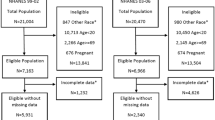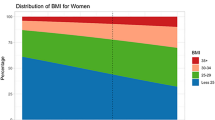Abstract
Background:
Surveys such as the Behavioral Risk Factor Surveillance System (BRFSS) collect only self-reported data on height and weight to estimate obesity prevalence rates. Because of biased self-reporting of height and weight, obesity prevalence rates reported by these surveys are too low.
Objective:
To develop regression models that can predict corrected height, weight and obesity prevalence from self-reported data, as well as to compare obesity prevalence rates based on self-reported and modeled data and test for trends in obesity prevalence by gender, age and race/ethnicity.
Design:
Data from the National Health and Nutrition Examination Survey (NHANES) for the period 1999–2006 were used to develop regression models to predict corrected height, weight and obesity prevalence. Regression coefficients estimated from these models were used to predict corrected height, weight and obesity prevalence for BRFSS data for 1999–2007.
Results:
Self-reported weights for males were higher by 0.1–0.2 kg and lower by about 1.25 kg than corrected weights for females. Underreporting of weights was lowest for Hispanics when compared with other race/ethnicities. In addition, underreporting of weight increased with an increase in body mass index. Self-reported heights for males were higher than corrected heights by about 2 cm, and for females, by about 1 cm. Overreporting of height increased with an increase in age. Self-reported obesity prevalence was 4.5–5.8% lower than corrected rates for males and by 4.4–5.1% for females. Underreporting of obesity prevalence increased with an increase in age. Obesity prevalence rates increased over time for each gender, race/ethnicity and age group for BRFSS data.
Conclusion:
Obesity prevalence calculated from self-reported data is too low and should be used with caution for health-care planning purposes. When it is not possible to have measured data, corrected heights and weights may be predicted by using models such as those presented by us from a relatively large data set that has both measured and self-reported data.
This is a preview of subscription content, access via your institution
Access options
Subscribe to this journal
Receive 12 print issues and online access
$259.00 per year
only $21.58 per issue
Buy this article
- Purchase on Springer Link
- Instant access to full article PDF
Prices may be subject to local taxes which are calculated during checkout

Similar content being viewed by others
References
Pi-Sunyer FX . Medical hazards of obesity. Ann Intern Med 1993; 119: 655–660.
Bays HE, Bazata DD, Clark NG, Gavin III JR, Green AJ, Lewis SJ et al. Prevalence of self-reported diagnosis of diabetes mellitus and associated risk factors in a national survey in the US population: SHIELD. BMC Public Health 2007; 7: 277.
Pearson WS . Ten-year comparison of estimates of overweight and obesity, diagnosed diabetes and use of office-based physician services for treatment of diabetes in the United States. Prev Med 2007; 45: 353–357.
Gregg EW, Cheng YJ, Narayan KMV, Thompson TJ, Williamson DF . The relative contribution of different levels of overweight and obesity to the increased prevalence of diabetes in the United States: 1976–2004. Prev Med 2007; 45: 348–352.
Weinstein AR, Sesso HD, Lee IM, Cook NR, Manson JE, Buring JE et al. Relationship of physical activity vs body mass index with Type 2 diabetes in women. JAMA 2004; 292: 1188–1194.
Hu G, Tuomilehto J, Silvertoinen K, Sarti C, Mannisto S, Jousilahti P . Body mass index, waist circumference, and waist-hip ratio on the risk of total and type-specific stroke. Arch Intern Med 2007; 167: 1420–1427.
Folsom AR, Prineas RJ, Kaye SA, Munger RG . Incidence of hypertension and stroke in relation to body fat distribution and other risk factors in older women. Stroke 1990; 21: 701–706.
Wilson PWF, DiAgostino RB, Sullivan L, Parise H, Kannel WB . Overweight and obesity as determinants of cardiovascular risk. Arch Intern Med 2002; 162: 1867–1872.
Yusuf S, Hawken S, Onupuu S, Bautista L, Franzosi MG, Commerford P et al. Obesity and the risk of myocardial infarction in 27000 participants from 52 countries: a case-control study. Lancet 2005; 366: 1640–1649.
Wessel TR, Arant CB, Olson MB, Johnson BD, Reis SE, Sharaf BL et al. Relationship of physical fitness vs body mass index with coronary artery disease and cardiovascular events in women. JAMA 2004; 292: 1179–1187.
Xu WH, Matthews CE, Xiang YB, Zheng W, Ruan ZX, Cheng JR et al. Effect of adiposity and fat distribution on endometrial cancer risk in Shanghai women. Am J Epidemiol 2005; 161: 939–947.
Wee CC, McCarthy EP, Davis RB, Phillips RS . Screening for cervical and breast cancer: is obesity an unrecognized barrier to preventive care. Ann Intern Med 2000; 132: 697–704.
Bergstorm A, Pisani P, Tenet V, Wolk A, Adami HO . Overweight as an avoidable cause of cancer in Europe. Int J Cancer 2001; 91: 421–430.
Roberts RE, Kaplan GA, Shema SJ, Strawbridge WJ . Are the obese at greater risk for depression? Am J Epidemiol 2000; 152: 163–170.
Onyike CU, Crum RM, Lee HB, Lyketsos CG, Eaton WW . In obesity associated with major depression? Results from the Third National Health and Nutrition Examination Survey. Am J Epidemiol 2003; 158: 1139–1147.
Karunakar MA, Shah SN, Jerabek S . Body mass index as predictor of complications after operative treatment of acetabular fractures. J Bone Joint Surg Am 2005; 87A: 1498–1502.
Tsujinaka T, Sasako M, Yamamoto S, Sano T, Kurokawa Y, Nashimoto A et al. Influence of overweight on surgical complications for gastric cancer: results from a randomized control trial comparing D2 and expended para-aoritic D3 lymphadenetomy. Ann Surg Oncol 2007; 14: 355–361.
Thomas F, Bean K, Pannier B, Oppert JM, Guize L, Benetos A . Cardiovascular mortality in overweight subjects. The key role of associated risk factors. Hypertension 2005; 46: 654–659.
Flegal KM, Graubard BI, Williamson DF, Gail MH . Excess deaths associated with underweight, overweight, and obesity. JAMA 2005; 293: 1861–1867.
Adams KF, Schatzkin A, Harris TB, Kipnis V, Mouw T, Ballard-Barbash R et al. Overweight, obesity, and mortality in a large cohort of persons 50 to 71 years old. N Engl J Med 2006; 355: 763–778.
Flegal KM, Graubard BI, Williamson DF, Gail MH . Cause specific deaths associated with underweight, overweight, and obesity. JAMA 2007; 298: 2028–2037.
Weitoft GR, Eliasson M, Rosen M . Underweight, overweight and obesity as risk factors for mortality and hospitalization. Scand J Public Health 2008; 36: 169–176.
Alley DE, Chang VW . The changing relationship of obesity and disability. JAMA 2007; 298: 2020–2027.
Ohki T, Tateishi R, Sato T, Masuzaki R, Imamura J, Goto T et al. Obesity is an independent risk factor for hepatocellular carcinoma development in chronic hepatitis C patients. Clin Gastroenterol Hepatol 2008; 6: 459–464.
Petry NM, Barry D, Pietrzak RH, Wagner JA . Overweight and obesity are associated with psychiatric disorders: results from the National Epidemiological Survey on alcohol and related conditions. Psychosom Med 2008; 70: 288–297.
Heo M, Allison DB, Faith MS, Zhu S, Fontaine KR . Obesity and quality of life: mediating effects of pain and comorbidities. Obes Res 2003; 11: 209–216.
Field AE, Coakley EH, Must A, Spadano JL, Laird N, Dietz WH et al. Impact of overweight on the risk of developing common chronic diseases during a 10-year period. Arch Intern Med 2001; 16: 1581–1586.
Bodnar LM, Ness RB, Markovi N, Roberts JM . The risk of preeclampsia with increasing prepregnancy body mass index. Ann Epidemiol 2005; 15: 475–482.
Gilboa SM, Currea A, Alverson CJ . Use of spline regression in an anlysis of maternal prepregnancy body mass index and adverse birth outcomes: does it tell us more than we already know? Ann Epidemiol 2008; 18: 196–205.
Dawood S, Broglio K, Gonzalez-Angulo AM, Kau SW, Islam R, Hortobagyi GN et al. Prognostic value of body mass index in locally advanced breast cancer. Clin Cancer Res 2008; 14: 1718–1725.
Centers for Disease Control and Prevention. Behavioral risk factor surveillance system. [Last accessed on 30 January 2010]. Available from http://www.cdc.gov/brfss.
Yun S, Zhu B-P, Black W, Brownson RC . A comparison of national estimates of obesity prevalence from the behavioral risk factor surveillance system and the national health and nutrition examination survey. Int J Obes 2006; 30: 164–170.
Centers for Disease Control and Prevention. National Health and Nutrition Survey. [Last accessed on 30 January 2010]. Available from http://www.cdc.gov/nchs/nhanes.htm.
Nyholm M, Gullberg B, Merlo J, Lundqvist-Persson C, Rastam L, Lindblad U . The validity of obesity based on self-reported weight and height: implications for population studies. Obesity 2007; 15: 197–207.
Ezzati M, Martin H, Skjold S, Hoorn SV, Murray C . Trends in national and state-level obesity in the USA after correction for self-report bias: analysis of health surveys. J R Soc Med 2006; 99: 250–257.
Villanueva E . The validity of self-reported weight in US adults: a population based cross-sectional study. BMC Pub Health 2001; 1: 11.
Engstrom JL, Paterson PA, Doherty A, Trabulsi M, Speer KL . Accuracy of self-reported height and weight in women: am integrative review of literature. J Midwifery Women Health 2003; 48: 338–345.
Ogden CL, Carroll MD, Curtin LR, McDowell MA, Tabak CJ, Flegal KM . Prevalence of overweight and obesity in the United States, 1999–2004. JAMA 2006; 295: 1549–1555.
Acknowledgements
We gratefully acknowledge the contributions of two anonymous referees who not only thoroughly reviewed an earlier version of this paper but also provided many constructive comments that substantially improved the regression models that we present in this paper.
Author information
Authors and Affiliations
Corresponding author
Ethics declarations
Competing interests
The author declares no conflict of interest.
Additional information
Disclaimer
The findings and conclusions in this article are those of the authors and do not necessarily represent the views of the Centers for Disease Control and Prevention.
Rights and permissions
About this article
Cite this article
Jain, R. Regression models to predict corrected weight, height and obesity prevalence from self-reported data: data from BRFSS 1999–2007. Int J Obes 34, 1655–1664 (2010). https://doi.org/10.1038/ijo.2010.80
Received:
Revised:
Accepted:
Published:
Issue Date:
DOI: https://doi.org/10.1038/ijo.2010.80
Keywords
This article is cited by
-
Assessing the importance of relative body weight in shaping life satisfaction: Evidence from 1 million Americans
Current Psychology (2022)
-
Consistent self-monitoring in a commercial app-based intervention for weight loss: results from a randomized trial
Journal of Behavioral Medicine (2020)
-
The accuracy of parent-reported height and weight for 6–12 year old U.S. children
BMC Pediatrics (2018)
-
A possible dose–response association between distance to farmers’ markets and roadside produce stands, frequency of shopping, fruit and vegetable consumption, and body mass index among customers in the Southern United States
BMC Public Health (2017)
-
Parental optimism about childhood obesity-related disease risks
International Journal of Obesity (2017)



